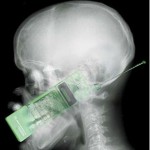Cell Phones: Where’s my earpiece?
 Cell phone usage has increased dramatically in recent years, with the number of subscribers exceeding 3 billion subscribers worldwide. Numerous case-control studies have examined the possible correlation between long term use of cell phones (specifically, the electromagnetic radiation emitted by cell phones) and the incidence of brain tumors.
Cell phone usage has increased dramatically in recent years, with the number of subscribers exceeding 3 billion subscribers worldwide. Numerous case-control studies have examined the possible correlation between long term use of cell phones (specifically, the electromagnetic radiation emitted by cell phones) and the incidence of brain tumors.
In the fall of 2009, the World Health Organization published a 10 year study which examined the cell phone habits of more than 120,000 people in 13 countries. The study reported a significantly higher risk of developing brain tumors in individuals with 10 years or more of cell phone usage. Similar findings in other studies have added to the growing concern over long-term exposure to cell phone usage.
In 2007, Dr. Lennart Hardell, from Örebro University in Sweden, reported an increased risk of malignant glioma in cell phone users, and that a daily one hour exposure significantly increased the risk for developing a brain tumor after 10 years. Recently, Dr. Ronald B. Herberman, director emeritus of the University of Pittsburgh Cancer Institute delivered a memo to over 3000 staff and faculty members, essentially warning them of the health risks of cell phone use, and specifically stated that children should limit cell phone use to emergencies only.
So why aren’t cell phones packaged with health warning labels in the same way that alcohol and cigarettes are labeled? The jury is out on whether the cell-phone and brain tumor link is convincing enough to warrant major concerns. In fact, the number of studies that render the link inconclusive far outnumber the studies which do (arguably, though, we can exclude studies funded by telecommunication companies). Discrepancy in these findings is due in large part to the inherent bias found in case-control studies, which are designed to examine specific factors that may contribute to a disease process or illness by comparing similarly matched individuals, those with and without the medical condition in question. In this case, the studies essentially rely on the participant’s recall of cell phone usage patterns as far back as 10 years.
Further substantiation of the clinical health risks posed by cell phone usage will need to include cohort studies, where healthy individuals, with and without exposure to cell phones are followed over a period of time and examined for occurrence of brain tumors. This of course means that it will take years to adequately determine the health risk. In the meantime, it may serve us well to heed recommendations to limit exposure to the electromagnetic radiation emitted by cell phones.
References:
http://artpredator.files.wordpress.com/2009/03/cell-phones-on-planes.jpg
http://www.webmd.com/cancer/brain-cancer/news/20091203/cell-phones-and-brain-tumors-no-connection
http://www.ncbi.nlm.nih.gov/pubmed/17409179
http://www.post-gazette.com/downloads/20080722upci_cellphone_memo.pdf
http://www.cancer.gov/cancertopics/factsheet/Risk/cellphones
http://www.medicalnewstoday.com/articles/161960.php
http://www.reuters.com/article/idUSTRE59C5GA20091013
http://www.newser.com/story/69023/report-revives-fears-of-cell-phone-tumor-link.html
http://www.physorg.com/news175853675.html
| Print article | This entry was posted by rios on January 29, 2010 at 5:56 pm, and is filed under Inside Cancer. Follow any responses to this post through RSS 2.0. You can skip to the end and leave a response. Pinging is currently not allowed. |









